The King has left the building.
It's been 26 years since King Ely Culbertson and his crowner, District 8’s Homer Shoop,
said goodbye to the International Palace of Sports.
It was possibly the only place on earth that enshrined a bridge player as a sports hero. It placed him in a special kingdom and endowed him with the same legendary stature as Red Grange, Muhammad Ali and Arnold Palmer, who also ruled kingdoms there. At one time, thousands visited this sports mecca every year.
Today, the icon of bridge great Ely Culbertson reigns over an annual keg party and his former realm – the International Palace of Sports – is a discount shoe store.
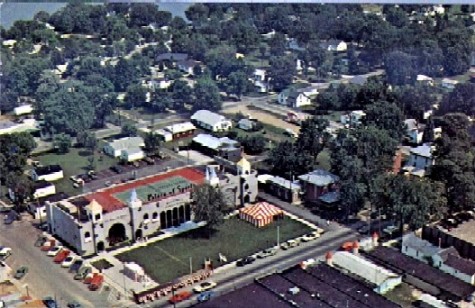 The
Palace was a unique "hall of fame" of recreation founded by District 8 bridge player
Homer Shoop.
For almost two decades, the Palace attracted thousands of tourists to the
northern Indiana community of North Webster, population 456 in 1970.
The
Palace was a unique "hall of fame" of recreation founded by District 8 bridge player
Homer Shoop.
For almost two decades, the Palace attracted thousands of tourists to the
northern Indiana community of North Webster, population 456 in 1970.
A local banker, Shoop was the visionary behind a medieval-themed tourism campaign that transformed the town. He rebuilt an entire block into Camelot Square (photo, right) and made his new, turreted Palace – complete with indoor fountains and rooftop tennis courts -- its centerpiece.
Shoop rebuilt his bank to resemble a castle and changed its name to The Counting House. Other local businesses soon followed his lead, adopting new names such as King’s Keg Package Liquors and Ye Olde Double Dip & Dunk It.
The Palace museum opened in 1974. Divided into "kingdoms" of football, baseball and other popular sports, it immortalized its heroes in wax statues, oil paintings and giant plaster checkers on an illuminated checkerboard. Other exhibits featured sports memorabilia and taped audio histories of each athlete.
The King of Bridge
The hero closest to Shoop’s heart was the King of Bridge, who ruled over the “Kingdom of Other Sports”. The life-size wax figure of Ely Culbertson peered somewhat sternly above visitors’ heads, sporting a five-o’clock shadow and holding an odd collection of eight red cards headed by the diamond jack.
Thanks to Shoop’s flair for promotion, the Palace and the town thrived. ABC broadcaster Chris Schenkel signed on as the "King Arthur" of the organization. Each year, the National Sportscasters and Sportswriters Association chose a King of Sports who came to North Webster for a parade and the unveiling of a new wax figure, checker and painting in the museum.
The first honoree in 1972 was Olympic swimmer Mark Spitz. In the following years, as many as 50,000 people crowded into the tiny town to see Muhammad Ali, Hank Aaron, A.J. Foyt, Archie Griffin, Larry Bird and others crowned Kings of Sports.
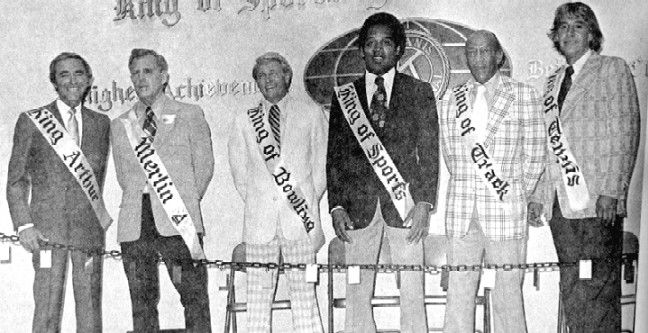
The star-studded 1974 festival celebrated OJ Simpson as King of Sports and
honored several other athletes. On stage for the coronation were
(from left) Chris Schenkel, Homer Shoop, Dick Weber (King of
Bowling), Simpson, Jesse Owens (King of Track) and Pancho Gonzales (King of
Tennis). Johnny Weismuller (King of Swimming) was also in attendance.
The final auction
In 1979, when Shoop sold the bank and moved to Florida to play bridge full-time, the energy for the tourism campaign left with him. The Palace board let the building fall into disrepair and cut back on promotions for the annual festival. Walter Payton and Bobby Knight, the 1985 and 1986 Kings of Sports, didn't even come to town. The last King of Sports was Jimmy Houston, a professional fisherman whose main qualification was a promise to show up.
The Palace closed in 1989 and the collection was sold at public auction in April, 1990. Highest bids were $1500 for the wax statue of hockey star Wayne Gretzky and $14,000 for Rocky Marciano's championship belt with its two pounds of gold. Cheapest price was $1 for a box of wax fingers.
Greg Kline, a Champaign IL newspaper reporter, went to the auction with friends from his hometown near North Webster. He left with a painting of Bronco Nagurski and the item he came to buy: the wax figure of Culbertson, which sold for $400. Its original cost was $2500.
"I could have gotten him for as little as $100," said Kline. "But a lady bridge player ran up the price." The losing bidder was Ruth McConnell, former ACBL president and our District 8 representative to the ACBL Board.
Kline didn't play bridge, but wanted the Culbertson statue as a prop for the International Festival of Other Sports – an annual gathering of 50+ games enthusiasts who adapted their tournament name from the Palace kingdom where Culbertson reigned. They convened every Labor Day weekend for bowling, miniature golf, table games and other competitions. The championship prize was always kegs of beer shared by all teams.
Other wax figures from the Palace found new homes in basements, bars and restaurants throughout the Midwest. The King of Bridge found his at a summer tournament. There was no bridge played there, but Ely Culbertson still reigned over the realm of recreation.
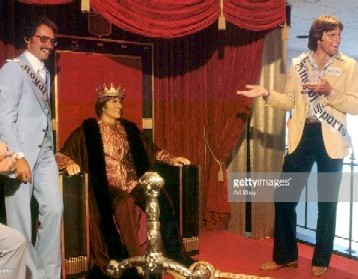
1976 King of Sports Bruce Jenner is
introduced to his wax likeness.
Shoop's legacy
Shoop was playing at the Mesa AZ regional the weekend of the auction and wasn’t consulted about the sale. He was deeply disappointed when he heard the news, but came through for the town again with $250,000 to fund bridge and tennis scholarships and turn the Palace grounds into a public park. He died a few months later.
The Palace and North Webster’s shining moment as Camelot are now distant memories, but Shoop’s legacy lives on. When he built the Palace, he established a youth sports foundation that is still active. His gifts also continue to support the town's annual Mermaid Festival.
Shoop's generosity is still enriching the game of bridge, too. In 1983, he made a large donation to the District 8 Board to establish and begin publishing this newsletter. In 1973, he created ACBL’s King or Queen of Bridge award, given annually to a high-school senior who was also honored in the Palace. In 1987, he formed and funded the ACBL Educational Foundation, which now awards the $1000 prizes. 2016 marks the 44th consecutive year of the King or Queen of Bridge competition.
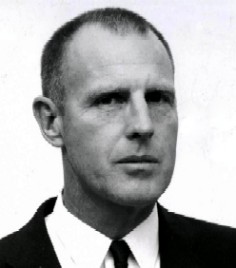 Homer Shoop (1912-1991)
Homer Shoop (1912-1991)
The founder of the International Palace of Sports, Shoop was a gifted promoter and benefactor for bridge, sports and his community.
He began his career at age 12 in a Michigan bank. At 17, he won a national typing championship and by 19, he was a newspaper reporter, court stenographer and owner of a business college. At 21, he became the youngest bank CEO in the nation. He was 34 when he bought the Farmers State Bank in North Webster IN.
In 1970, he created the Shoop Sports and Youth Foundation, which has provided more than $3.6 million to fund community projects and scholarships, including ACBL’s King or Queen of Bridge award.
Shoop was also a tennis champion. He began winning tournaments as a teenager and became a world-ranked senior. He played in the senior championships at Wimbledon in 1967 and was inducted into the International Tennis Hall of Fame in 1989.
Even more impressive was his bridge career, which began with championships in the 1930s. He was second in the Life Master Pairs in 1980 and was twice Senior Player of the Year. He was the first player over age 75 to win 1000 points in a year, and he did it with dozens of different partners, from pros to novices. His lifetime total was more than 10,440 masterpoints.
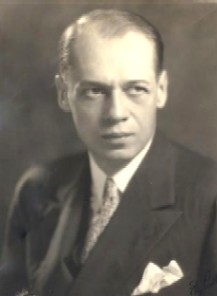 Ely Culbertson (1891-1955)
Ely Culbertson (1891-1955)
If bridge has a "king", Culbertson was arguably the Palace's best choice. One of the greatest players of all time, he was a wildly successful, often brash, promoter of contract bridge and his own Culbertson System in the 1930s. He is generally credited with making the game an internationally popular pastime.
Culbertson and his wife Jo founded The Bridge World magazine in 1929 and gained worldwide prominence during the famous Culbertson-Lenz match of 1932. Called "The Battle of the Century", the 150-rubber match pitted Ely and Jo against leading auction player Sidney Lenz, who was given 5:1 odds. The Culbertsons' win resulted in lucrative contracts for newspaper columns, movie shorts and a $10,000-a-week radio program.
Although he never became an ACBL Life Master, Culbertson was a dominant tournament winner and bridge authority. Much of today's game is based on his contributions, which include limited notrump rebids, the new-suit-forcing concept and Grand Slam Force. He also devised duplicate scoring and the vulnerability on duplicate boards.
The Culbertsons divorced in 1938 and Ely devoted the last 17 years of his life to political activism for world peace. His proposals were influential in forming the United Nations and he lectured and published books on political science.
His autobiography, The Strange Lives of One Man, was published in 1940. He died at age 64 of a common cold complicated by emphysema.